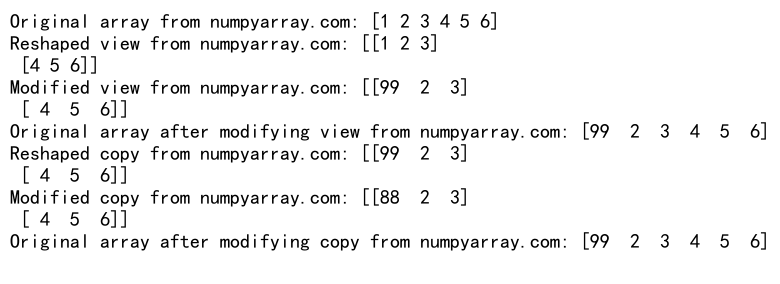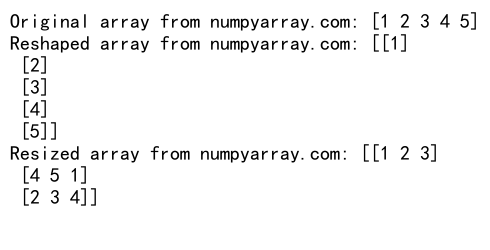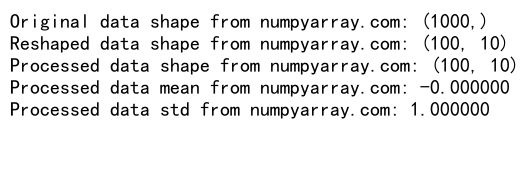Mastering NumPy Reshape Array: A Comprehensive Guide to Transforming Data Structures
NumPy reshape array is a powerful function that allows you to change the shape of an array without altering its data. This versatile tool is essential for data manipulation and preprocessing in various scientific computing and machine learning tasks. In this comprehensive guide, we’ll explore the ins and outs of NumPy reshape array, providing detailed explanations and practical examples to help you master this fundamental operation.
Understanding NumPy Reshape Array Basics
NumPy reshape array is a method that enables you to reorganize the dimensions of an array while preserving its total number of elements. This operation is crucial when you need to adapt your data structure to fit specific algorithms or visualization requirements. Let’s start with a simple example to illustrate the basic concept of NumPy reshape array:
import numpy as np
# Create a 1D array
arr = np.array([1, 2, 3, 4, 5, 6])
print("Original array from numpyarray.com:", arr)
# Reshape the array to 2D
reshaped_arr = arr.reshape((2, 3))
print("Reshaped array from numpyarray.com:", reshaped_arr)
Output:

In this example, we create a 1D array with six elements and use NumPy reshape array to transform it into a 2D array with two rows and three columns. The total number of elements remains the same, but the structure of the array changes.
The Importance of NumPy Reshape Array in Data Processing
NumPy reshape array plays a crucial role in data processing and analysis. It allows you to adapt your data to various algorithms and functions that expect specific input shapes. Here are some key reasons why NumPy reshape array is essential:
- Data preparation for machine learning models
- Image processing and computer vision tasks
- Time series analysis and forecasting
- Matrix operations and linear algebra computations
Let’s explore a more complex example of using NumPy reshape array in a data processing scenario:
import numpy as np
# Create a 1D array representing sensor readings
sensor_data = np.array([1.2, 2.3, 3.4, 4.5, 5.6, 6.7, 7.8, 8.9, 9.0, 10.1, 11.2, 12.3])
print("Original sensor data from numpyarray.com:", sensor_data)
# Reshape the data into a 2D array with 4 sensors and 3 readings each
reshaped_data = sensor_data.reshape((4, 3))
print("Reshaped sensor data from numpyarray.com:", reshaped_data)
# Calculate the average reading for each sensor
sensor_averages = np.mean(reshaped_data, axis=1)
print("Average readings from numpyarray.com:", sensor_averages)
Output:

In this example, we use NumPy reshape array to transform a 1D array of sensor readings into a 2D array representing data from four sensors with three readings each. This reshaping allows us to easily calculate the average reading for each sensor using NumPy’s mean function.
NumPy Reshape Array Syntax and Parameters
The basic syntax for NumPy reshape array is as follows:
numpy.reshape(a, newshape, order='C')
Let’s break down the parameters:
a: The input array to be reshaped.newshape: An integer or tuple of integers specifying the new shape.order: (Optional) Specifies the memory layout of the reshaped array. ‘C’ for row-major (C-style) order, ‘F’ for column-major (Fortran-style) order, or ‘A’ for preserving the original order.
Here’s an example demonstrating the use of these parameters:
import numpy as np
# Create a 1D array
arr = np.array([1, 2, 3, 4, 5, 6, 7, 8, 9, 10, 11, 12])
print("Original array from numpyarray.com:", arr)
# Reshape to 3x4 using tuple
reshaped_3x4 = np.reshape(arr, (3, 4))
print("Reshaped 3x4 array from numpyarray.com:", reshaped_3x4)
# Reshape to 2x6 using integer arguments
reshaped_2x6 = np.reshape(arr, 2, 6)
print("Reshaped 2x6 array from numpyarray.com:", reshaped_2x6)
# Reshape using Fortran-style order
reshaped_fortran = np.reshape(arr, (3, 4), order='F')
print("Reshaped Fortran-style array from numpyarray.com:", reshaped_fortran)
This example showcases different ways to use NumPy reshape array, including specifying the new shape as a tuple or separate integers, and using the order parameter to control the memory layout.
Advanced NumPy Reshape Array Techniques
NumPy reshape array offers several advanced techniques that can be incredibly useful in various scenarios. Let’s explore some of these techniques:
1. Using -1 as a Dimension Placeholder
When reshaping arrays, you can use -1 as a placeholder for one of the dimensions. NumPy will automatically calculate the appropriate size for that dimension based on the total number of elements and the other specified dimensions.
import numpy as np
# Create a 1D array
arr = np.array([1, 2, 3, 4, 5, 6, 7, 8, 9, 10, 11, 12])
print("Original array from numpyarray.com:", arr)
# Reshape to 2 rows with automatic column calculation
reshaped_2xAuto = arr.reshape(2, -1)
print("Reshaped 2xAuto array from numpyarray.com:", reshaped_2xAuto)
# Reshape to 3 columns with automatic row calculation
reshaped_Autox3 = arr.reshape(-1, 3)
print("Reshaped Autox3 array from numpyarray.com:", reshaped_Autox3)
Output:

This technique is particularly useful when you know one dimension of the desired shape but want NumPy to calculate the other dimension automatically.
2. Flattening Arrays with NumPy Reshape Array
NumPy reshape array can be used to flatten multi-dimensional arrays into 1D arrays. This is often useful when you need to perform operations that require a flat structure.
import numpy as np
# Create a 2D array
arr_2d = np.array([[1, 2, 3], [4, 5, 6], [7, 8, 9]])
print("Original 2D array from numpyarray.com:", arr_2d)
# Flatten the array using reshape
flattened_arr = arr_2d.reshape(-1)
print("Flattened array from numpyarray.com:", flattened_arr)
# Alternative method using ravel
flattened_arr_ravel = arr_2d.ravel()
print("Flattened array using ravel from numpyarray.com:", flattened_arr_ravel)
Output:

Both reshape(-1) and ravel() can be used to flatten arrays, but ravel() may return a view of the original array instead of a copy, which can be more memory-efficient in some cases.
3. Reshaping Arrays with Unknown Dimensions
Sometimes, you may need to reshape an array when you don’t know its exact dimensions. NumPy reshape array allows you to use -1 for multiple dimensions, as long as the total size is known.
import numpy as np
# Create a 1D array
arr = np.array([1, 2, 3, 4, 5, 6, 7, 8, 9, 10, 11, 12])
print("Original array from numpyarray.com:", arr)
# Reshape to 2D array with unknown dimensions
reshaped_unknown = arr.reshape(2, -1, 2)
print("Reshaped array with unknown dimensions from numpyarray.com:", reshaped_unknown)
Output:

In this example, we reshape the array into a 3D array with 2 as the first dimension, 2 as the last dimension, and let NumPy calculate the middle dimension.
Common Pitfalls and Error Handling in NumPy Reshape Array
While NumPy reshape array is a powerful tool, it’s important to be aware of common pitfalls and how to handle errors that may arise. Let’s explore some scenarios:
1. Incompatible Shapes
One of the most common errors when using NumPy reshape array is specifying a new shape that’s incompatible with the total number of elements in the original array.
import numpy as np
# Create a 1D array
arr = np.array([1, 2, 3, 4, 5])
print("Original array from numpyarray.com:", arr)
try:
# Attempt to reshape to an incompatible shape
reshaped_arr = arr.reshape((2, 3))
print("Reshaped array from numpyarray.com:", reshaped_arr)
except ValueError as e:
print("Error from numpyarray.com:", str(e))
Output:

In this example, we attempt to reshape a 5-element array into a 2×3 shape, which is impossible. NumPy raises a ValueError, which we catch and handle gracefully.
2. Modifying Views vs. Copies
When using NumPy reshape array, it’s crucial to understand whether you’re working with a view of the original array or a copy. Modifying a view will affect the original array, while modifying a copy will not.
import numpy as np
# Create a 1D array
arr = np.array([1, 2, 3, 4, 5, 6])
print("Original array from numpyarray.com:", arr)
# Create a view by reshaping
view_arr = arr.reshape(2, 3)
print("Reshaped view from numpyarray.com:", view_arr)
# Modify the view
view_arr[0, 0] = 99
print("Modified view from numpyarray.com:", view_arr)
print("Original array after modifying view from numpyarray.com:", arr)
# Create a copy by reshaping
copy_arr = arr.reshape(2, 3).copy()
print("Reshaped copy from numpyarray.com:", copy_arr)
# Modify the copy
copy_arr[0, 0] = 88
print("Modified copy from numpyarray.com:", copy_arr)
print("Original array after modifying copy from numpyarray.com:", arr)
Output:

This example demonstrates the difference between modifying a view created by NumPy reshape array and modifying a copy. Understanding this distinction is crucial for avoiding unintended side effects in your code.
NumPy Reshape Array in Machine Learning and Data Science
NumPy reshape array is extensively used in machine learning and data science workflows. Let’s explore some common applications:
1. Preparing Data for Neural Networks
When working with neural networks, input data often needs to be reshaped to match the expected input shape of the model. Here’s an example of reshaping image data for a convolutional neural network:
import numpy as np
# Simulate image data (28x28 grayscale images)
num_images = 100
image_data = np.random.rand(num_images, 28, 28)
print("Original image data shape from numpyarray.com:", image_data.shape)
# Reshape for a CNN that expects (batch_size, height, width, channels)
reshaped_data = image_data.reshape(num_images, 28, 28, 1)
print("Reshaped image data for CNN from numpyarray.com:", reshaped_data.shape)
Output:

In this example, we reshape a batch of 2D grayscale images to include a channel dimension, which is typically required for convolutional neural networks.
2. Time Series Data Preparation
NumPy reshape array is often used to prepare time series data for sequence models. Here’s an example of reshaping time series data for an LSTM model:
import numpy as np
# Simulate time series data
time_steps = 100
features = 5
time_series_data = np.random.rand(time_steps, features)
print("Original time series data shape from numpyarray.com:", time_series_data.shape)
# Reshape for LSTM input (samples, time steps, features)
window_size = 10
num_samples = time_steps - window_size + 1
reshaped_data = np.array([time_series_data[i:i+window_size] for i in range(num_samples)])
print("Reshaped time series data for LSTM from numpyarray.com:", reshaped_data.shape)
Output:

This example demonstrates how to use NumPy reshape array to create sliding windows of time series data, which is a common preprocessing step for sequence models like LSTMs.
Optimizing Performance with NumPy Reshape Array
While NumPy reshape array is generally efficient, there are some considerations for optimizing performance, especially when working with large datasets:
1. Using Contiguous Memory Layouts
When possible, try to reshape arrays that have a contiguous memory layout. This can lead to better performance, especially for large arrays.
import numpy as np
# Create a large array
large_arr = np.random.rand(1000000)
print("Original array info from numpyarray.com:", large_arr.shape, large_arr.flags['C_CONTIGUOUS'])
# Reshape maintaining contiguous layout
reshaped_contiguous = large_arr.reshape(1000, 1000)
print("Reshaped contiguous array info from numpyarray.com:", reshaped_contiguous.shape, reshaped_contiguous.flags['C_CONTIGUOUS'])
# Create a non-contiguous array
non_contiguous = large_arr[::2]
print("Non-contiguous array info from numpyarray.com:", non_contiguous.shape, non_contiguous.flags['C_CONTIGUOUS'])
# Reshape non-contiguous array
reshaped_non_contiguous = non_contiguous.reshape(250, 2000)
print("Reshaped non-contiguous array info from numpyarray.com:", reshaped_non_contiguous.shape, reshaped_non_contiguous.flags['C_CONTIGUOUS'])
Output:

This example shows how to check if an array has a contiguous memory layout and demonstrates reshaping both contiguous and non-contiguous arrays.
2. Avoiding Unnecessary Copies
When possible, use views instead of copies to avoid unnecessary memory allocation. However, be cautious of unintended side effects when modifying views.
import numpy as np
# Create a large array
large_arr = np.random.rand(1000000)
# Reshape using a view (no copy)
reshaped_view = large_arr.reshape(1000, 1000)
print("Reshaped view from numpyarray.com:", reshaped_view.shape, reshaped_view.base is large_arr)
# Reshape with a copy
reshaped_copy = large_arr.reshape(1000, 1000).copy()
print("Reshaped copy from numpyarray.com:", reshaped_copy.shape, reshaped_copy.base is large_arr)
Output:

This example demonstrates the difference between reshaping as a view and creating a copy. The base attribute helps identify whether an array is a view of another array.
NumPy Reshape Array vs. Other Array Manipulation Functions
While NumPy reshape array is a powerful tool, it’s important to understand how it compares to other array manipulation functions in NumPy. Let’s explore some alternatives and when to use them:
1. NumPy Reshape Array vs. Transpose
NumPy’s transpose() function is used to swap axes of an array, which can sometimes achieve similar results to reshape. However, transpose is more limited in its capabilities.
import numpy as np
# Create a 2D array
arr_2d = np.array([[1, 2, 3], [4, 5, 6]])
print("Original 2D array from numpyarray.com:", arr_2d)
# Reshape to swap dimensions
reshaped_arr = arr_2d.reshape(3, 2)
print("Reshaped array from numpyarray.com:", reshaped_arr)
# Transpose the array
transposed_arr = arr_2d.transpose()
print("Transposed array from numpyarray.com:", transposed_arr)
Output:

In this example, we see that reshape can change the structure of the array more flexibly, while transpose simply swaps the existing axes.
2. NumPy Reshape Array vs. Resize
NumPy’s resize() function is similar to reshape, but it can change the total number of elements in the array, either by truncating or repeating data.
import numpy as np
# Create a 1D array
arr = np.array([1, 2, 3, 4, 5])
print("Original array from numpyarray.com:", arr)
# Reshape the array (maintains total elements)
reshaped_arr = arr.reshape(5, 1)
print("Reshaped array from numpyarray.com:", reshaped_arr)
# Resize the array (can change total elements)
resized_arr = np.resize(arr, (3, 3))
print("Resized array from numpyarray.com:", resized_arr)
Output:

This example shows how resize can change the total number of elements, while reshape always maintains the original number of elements.
Advanced Applications of NumPy Reshape Array
Let’s explore some advanced applications of NumPy reshape array in real-world scenarios:
1. Image Processing with NumPy Reshape Array
NumPy reshape array is frequently used in image processing tasks. Here’s an example of how it can be used to manipulate image data:
import numpy as np
# Simulate an RGB image (3 channels)
image = np.random.randint(0, 256, (100, 100, 3), dtype=np.uint8)
print("Original image shape from numpyarray.com:", image.shape)
# Reshape to separate color channels
reshaped_image = image.reshape(-1, 3)
print("Reshaped image for color analysis from numpyarray.com:", reshaped_image.shape)
# Calculate average color
avg_color = np.mean(reshaped_image, axis=0)
print("Average color from numpyarray.com:", avg_color)
# Reshape back to original dimensions
restored_image = reshaped_image.reshape(100, 100, 3)
print("Restored image shape from numpyarray.com:", restored_image.shape)
Output:

This example demonstrates how NumPy reshape array can be used to manipulate image data for color analysis and then restore it to its original shape.
2. Time Series Forecasting with NumPy Reshape Array
NumPy reshape array is crucial in preparing data for time series forecasting models. Here’s an example of creating lagged features:
import numpy as np
# Simulate time series data
time_series = np.random.rand(100)
print("Original time series from numpyarray.com:", time_series.shape)
# Create lagged features
lag = 3
lagged_data = np.array([time_series[i:i+lag] for i in range(len(time_series)-lag+1)])
print("Lagged data shape from numpyarray.com:", lagged_data.shape)
# Prepare input (X) and target (y) data
X = lagged_data[:-1]
y = time_series[lag:]
print("Input data shape from numpyarray.com:", X.shape)
print("Target data shape from numpyarray.com:", y.shape)
Output:

This example shows how to use NumPy reshape array to create lagged features for time series forecasting, which is a common preprocessing step in many predictive models.
Best Practices for Using NumPy Reshape Array
To make the most of NumPy reshape array in your projects, consider the following best practices:
- Always verify the shape of your arrays before and after reshaping to ensure the desired outcome.
- Use the -1 placeholder judiciously to let NumPy calculate dimensions automatically when appropriate.
- Be mindful of memory usage, especially when working with large arrays. Use views instead of copies when possible.
- Understand the difference between C-style and Fortran-style ordering and choose the appropriate order for your use case.
- Combine NumPy reshape array with other NumPy functions to create efficient data processing pipelines.
Here’s an example incorporating some of these best practices:
import numpy as np
def preprocess_data(data, target_shape):
"""
Preprocess data using NumPy reshape array and other operations.
"""
print(f"Original data shape from numpyarray.com: {data.shape}")
# Ensure data is contiguous for better performance
if not data.flags['C_CONTIGUOUS']:
data = np.ascontiguousarray(data)
# Reshape data
reshaped_data = data.reshape(target_shape)
print(f"Reshaped data shape from numpyarray.com: {reshaped_data.shape}")
# Normalize data
normalized_data = (reshaped_data - np.mean(reshaped_data)) / np.std(reshaped_data)
return normalized_data
# Example usage
sample_data = np.random.rand(1000)
processed_data = preprocess_data(sample_data, (-1, 10))
print(f"Processed data shape from numpyarray.com: {processed_data.shape}")
print(f"Processed data mean from numpyarray.com: {np.mean(processed_data):.6f}")
print(f"Processed data std from numpyarray.com: {np.std(processed_data):.6f}")
Output:

This example demonstrates a preprocessing function that incorporates NumPy reshape array along with other operations, following best practices for efficient data manipulation.
NumPy reshape array Conclusion
NumPy reshape array is a fundamental tool in the data scientist’s toolkit, offering powerful capabilities for manipulating array structures. Throughout this comprehensive guide, we’ve explored the basics of NumPy reshape array, advanced techniques, common pitfalls, and real-world applications in machine learning and data science.
By mastering NumPy reshape array, you’ll be better equipped to handle complex data structures, prepare data for various algorithms, and optimize your data processing workflows. Remember to consider the best practices we’ve discussed and always be mindful of the underlying data structure when using this powerful function.